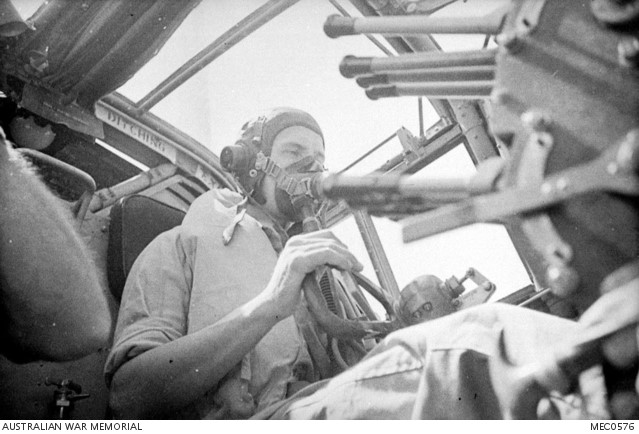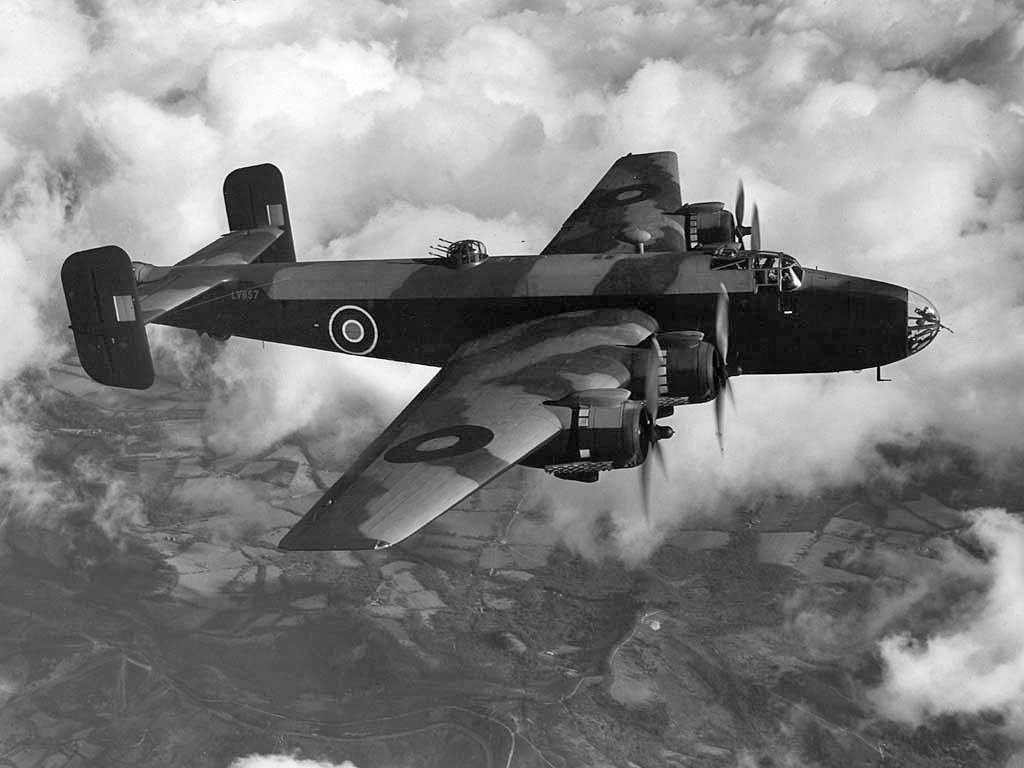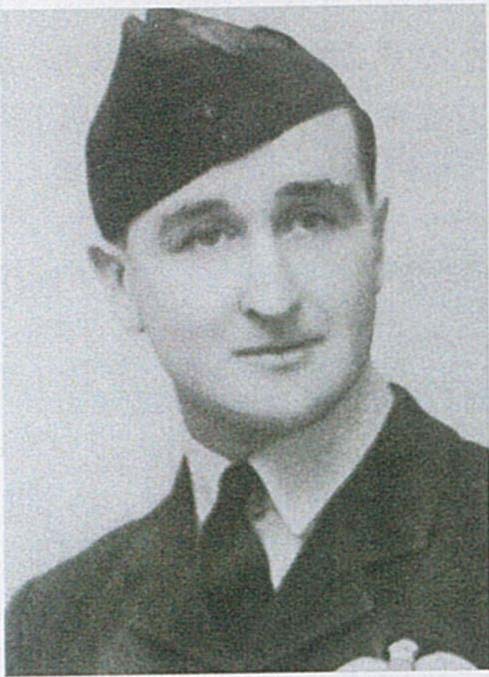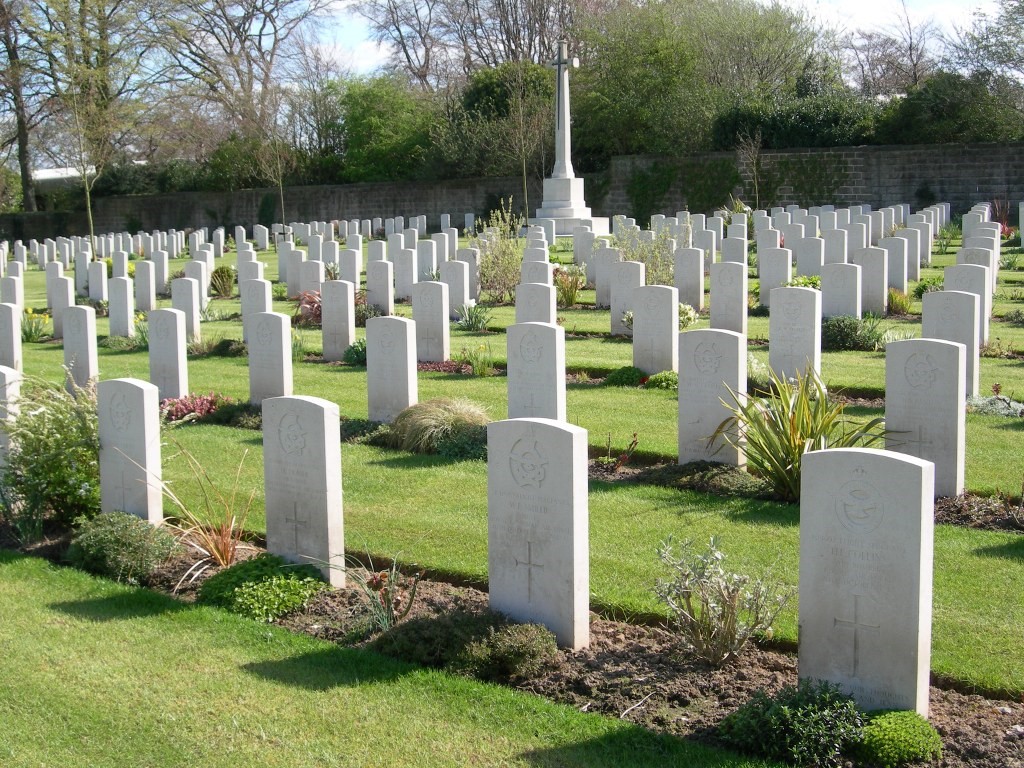Pilot Officer George Donaldson Jekyll, the son of George Ernest Jekyll and Lillian Olive Jekyll (nee Donaldson), was born at Emmaville in New South Wales on 22nd March 1921. He completed junior education at Scots College in Warwick, and senior education at Toowoomba Grammar School where he played 1st Rugby. He was enrolled into the Reserve of the Royal Australian Air Force on 3rd December 1940 after swearing an Oath of Affirmation and awarded Reserve Badge No. 9167. At the age of 27 years and 3 months he was enlisted into the Citizen Air Force of the R.A.A.F. at No. 3 Recruiting Centre in Brisbane on 22nd June 1941 after giving an undertaking that he would serve for the duration of the war and an additional twelve months. He was allotted the service number of 405914. Prior to his enlistment he was employed as a Jackeroo/Station Hand. His physical description at the time of his enlistment was that he was 5 feet 8 inches in height and weighed 147 pounds. He had a medium complexion, green eyes and medium coloured hair. He stated that he was of the Presbyterian religion. He gave his next of kin as his wife, Mrs Audrey Ella Jekyll, residing at “New Bon Accord”, Dalby, Queensland. They had one son, George William Jekyll, who was born on 31st October 1942.
Pilot Officer George Jekyll joined No. 3 Initial Training School at Sandgate in Queensland on 22nd June 1941. He joined No. 2 Elementary Flying Training School at Archerfield in Queensland on 16th October 1941. He joined No. 2 Service Flying Training School at Wagga Wagga in New South Wales on 14th December 1941. He was awarded the Flying Qualification Badge on 6th March 1942. He was promoted to the rank of Temporary Sergeant on 30th April 1942. He joined No. 5 Service Flying Training School at Uranquinty in New South Wales on 3rd April 1942. He joined No. 3 Embarkation Depot at Sandgate in Queensland on 3rd June 1942 and No. 2 Embarkation Depot at Bradfield Park in Sydney on 15th June 1942 to prepare for overseas service on attachment to the Royal Air Force. He embarked by sea transport from Sydney on 24th August 1942 and he disembarked in the United Kingdom on 18th November 1942 where he joined No. 3 Personnel Despatch and Reception Centre at Bournemouth later that day. During his transit to England he was promoted to the rank of Temporary Flight Sergeant on 30th October 1942. Pilot Officer George Jekyll joined No. 11 (Pilot) Advanced Flying Unit at Royal Air Force Shawbury in Shropshire on 19th January 1943. He joined No. 15 Operational Training Unit at Royal Air Force Station Harwell on 6th April 1943 where training was conducted to prepare aircrew for night bombing using Vickers Wellington aircraft. He was admitted seriously ill to the Royal Air Force Hospital at Halton suffering a pulmonary embolism on 15th June 1943. He was promoted to the rank of Temporary Warrant Officer on 30th October 1943. He joined No. 1150 Conversion Unit on 1st December 1943 where he received training on Halifax bombers. He joined No 102 (Ceylon) Squadron for operational duties at Royal Air Force Station Pocklington on 7th May 1944. No. 102 Squadron was a Heavy Bomber Squadron that carried out night bombing over Germany. In 1944 the squadron was involved in attacking rail targets in France in preparation for the invasion. He was appointed to the commissioned rank of Pilot Officer on 7th June 1944.
During his time in No. 102 Squadron, Jekyll flew both Halifax and Wellington bombers in raids over Germany. He was also chosen for the Pathfinder Force where he flew Mosquito night fighters to mark bombing targets with flares. This involved flying dangerously low over enemy territory in the dark of night. Some of Pilot Officer Jekyll’s bombing and flare targets include Heil Barbour, Stuttgart, Essen, Ruhr Valley, the 1000 bomber raids of in May and June 1944, and the Skoda workshops. No 102 Squadron had sustained the second casualty rate of all Bomber Command. In January of 1944 alone they lost eleven aircraft and by the end of the war 1015 members were killed while another 319 were captured.
Pilot Officer George Jekyll was the Pilot/Captain of a No. 102 (Ceylon) Squadron Halifax Bomber LW140 that crashed after striking a tree whilst flying low in bad weather at Home Farm Wassand, Seaton, near Hornsea, East Yorkshire, at 0355 hours on 9th June 1944. All seven crew members were killed. At the time of his death, George Jekyll was 23 years of age. He was buried with full service honours in the Harrogate Cemetery at 1145 hours on 14th June 1944.

Australian War Memorial photograph MEC076
A pilot at the controls of a Handley Page Halifax aircraft.
Flight Lieutenant Doyle of No. 102 Squadron sent the following letter to his wife on 10th June 1944:
Dear Mrs Jekyll, You will have received official notification advising you that your husband was killed as a result of air operations on the night of 8th June. Your husband was Captain and Pilot of an aircraft in my Flight detailed for a raid on Brest. The operation was completed successfully but unfortunately the aircraft crashed on its return to Base. Enquiries into the matter are still being conducted as to the possible cause of the crash and the unfortunate resultant loss of life of the whole crew. May I offer you the sincerest sympathies of our Squadron Commander and the whole Squadron especially those of his Flight and myself, in your sad loss. Though Warrant Officer Jekyll (sic) had only been with us a short time he had shown himself to be keen and enthusiastic and an excellent member of the Squadron. Apart from the fact that the Squadron can ill afford to lose such an excellent pilot, his loss to the Flight is much more personal. Before closing may I again offer you the condolence of the Squadron and our deepest sympathy. Yours Sincerely.
A Court of Inquiry into the crash concluded:
Halifax No. LW.140 flown by Warrant Officer Jekyll and crew of 6, having completed a successful night operation from R.A.F. Pocklington, returned to the vicinity of its base in the early hours of Friday 9th June 1944. At 03.46 Pocklington Flying Control instructed Jekyll to divert to Catfoss, as the weather was too bad at Pocklington, but he was not to fly below 1500 feet. Halifax No. LW.140 after acknowledging the signal made no further communication with the ground either at Pocklington or Catfoss. At 03.55 hours it struck an oak tree with its port wing while flying North at great speed in pulling out of a dive. The aeroplane started to break up with its final destruction being completed by further impact with a sycamore tree 180 yards further North. All personnel were killed.
The cause of this accident was flying too low in bad weather so that the aircraft port wing hit a tree. Why the aircraft was flying so low is obscure, but there is every appearance of its being pulled out of a dive at the time and it is thought that may have been the result of sudden avoiding action being taken by the pilot when meeting another aircraft in the vicinity. Suggest that Sandra Lights be obtained for Catfoss as soon as possible now that army searchlight units have gone from vicinity.
Pilot Officer George Jekyll’s name is commemorated on Panel No. 124 at the Australian War Memorial in Canberra and locally on the Dalby War Memorial WW2 Honour Plaque and the Toowoomba Grammar School WW2 Honour Board.
Note
The following report appeared in the Dalby Herald on Friday 16 June 1944:
ROLL OF HONOUR – Warrant Officer G. D. Jekyll .- The bad news of the death of Warrant Officer George Donaldson Jekyll, whilst on active service overseas with the R.A.A.F., was received by Mrs. Jekyll daring the week. A telegram from the Air Board conveyed the brief particulars that Warrant Officer Jekyll lost his life on the morning of June 9th last, as a result of flying operations near Hornsby, England, during bad weather. The Minister for Air and the Air Board conveyed regret and sympathy in the sad occurrence. Warrant Officer Jekyll, who was 30 years of age, was born near Glen Innes, New South Wales, and came to reside in Queensland with his parents, Mr. and Mrs G. E. Jekyll, when Mr Jekyll took over New Bon Accord station near Dalby, about twenty years ago.
Warrant Officer Jekyll was educated at the Scots College at Warwick and later at the Toowoomba Grammar School. After spending some time on New Bon Accord he enlisted for service with the R.A.A.F. in August 1941. In November 1941, Warrant Officer Jekyll’s marriage with Miss Audrey Thomas, of Roma, took place In Brisbane. He is survived by his widow and an infant son, his mother and father, Mr and Mrs G. E. Jekyll, of New Bon Accord, and a brother, Captain N. D. Jekyll, of the A.l.F. The passing of Warrant Officer Jekyll has been received with profound regret by the community of Dalby and district, where he was held in highest regards, and his name will be honoured as another of Australia’s noble sons who have paid the supreme sacrifice in the service of his country, and the cause for which the United Nations are fighting.
On 30th May 1967, Mr Alex B. Dixon of Post Office Box 27000, Mt Roskill, Auckland, New Zealand, wrote the following letter to the Air Force in Canberra:
Recently I was in Canberra and going through the War Memorial I noticed the name Jekel (sic) and was wondering if this was the same Sergeant Pilot who was in the R.A.F. hospital at Holton with me in 1943. It was the only Jekel on the list and I cannot remember his initials other than that he was a patient in the hospital for a muscle which had been badly torn while playing Rugby. I was wondering if these few particulars would make it possible for you to tell me if this was the same man, and if not, and if my friend had survived the war, if there was any way in which I could obtain his address. If my memory serves me right he was a back country farmer from Queensland.
The Air Force notified Alex Dixon that he had been the patient at the R.A.F. hospital in June 1943 and that he was killed during air operations near Hornsea, East Yorkshire on 9th June 1944.
On 15th January 1947, his wife’s address was changed to Roche Street, Dalby, Queensland.

A Handley Page Halifax bomber used by No. 102 (Ceylon) Squadron
Toowoomba Grammar School archive records show that he enrolled as a boarder on 6th August 1928 and left the School on 31st December 1930. He was also in the Rugby 1st XV in 1930.




